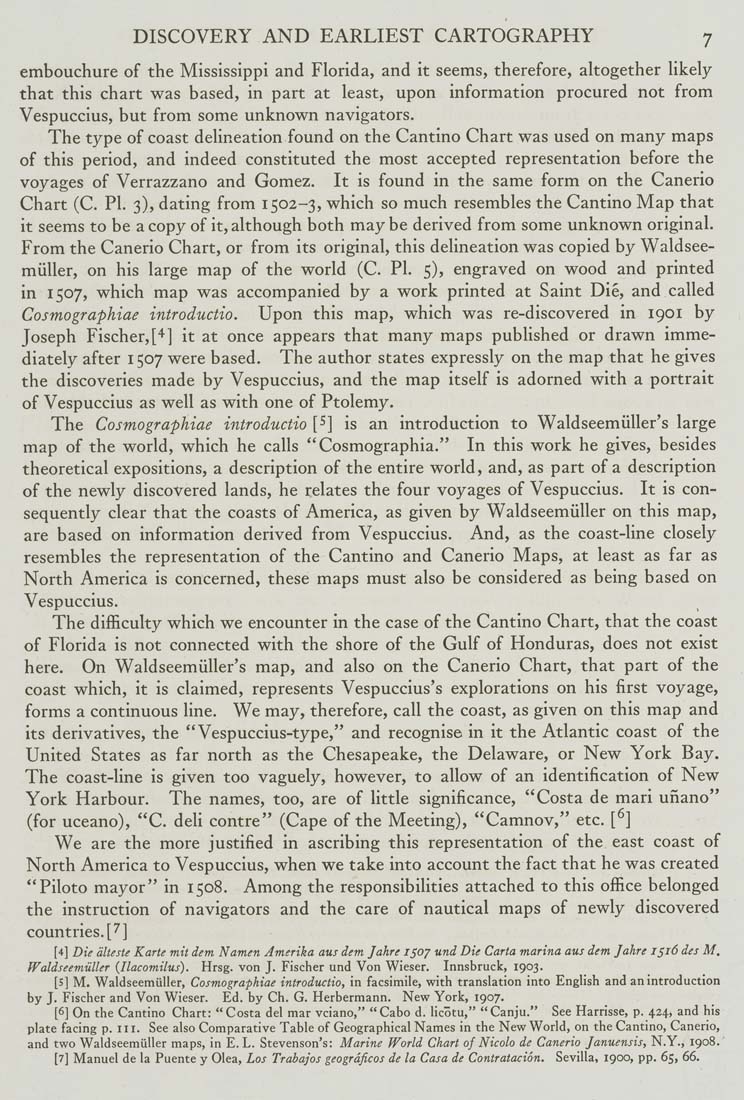DISCOVERY AND EARLIEST CARTOGRAPHY 7
embouchure of the Mississippi and Florida, and it seems, therefore, altogether likely
that this chart was based, in part at least, upon Information procured not from
Vespuccius, but from some unknown navigators.
The type of coast delineation found on the Cantino Chart was used on many maps
of this period, and indeed constituted the most accepted representation before the
voyages of Verrazzano and Gomez. It is found In the same form on the Canerio
Chart (C. PI. 3), dating from 1502-3, which so much resembles the Cantino Map that
it seems to be a copy of it, although both may be derived from some unknown original.
From the Canerio Chart, or from its original, this delineation was copied by Waldsee-
miiller, on his large map of the world (C. PI. 5), engraved on wood and printed
in 1507, which map was accompanied by a work printed at Saint Die, and called
Cosmographiae introductio. Upon this map, which was re-discovered In 1901 by
Joseph Fischer,[*] it at once appears that many maps published or drawn imme¬
diately after 1507 were based. The author states expressly on the map that he gives
the discoveries made by Vespuccius, and the map itself is adorned with a portrait
of Vespuccius as well as with one of Ptolemy.
The Cosmographiae introductio [5] is an Introduction to Waldseemuller's large
map of the world, which he calls "Cosmographia." In this work he gives, besides
theoretical expositions, a description of the entire world, and, as part of a description
of the newly discovered lands, he relates the four voyages of Vespuccius. It Is con¬
sequently clear that the coasts of America, as given by Waldseemiiller on this map,
are based on information derived from Vespuccius. And, as the coast-line closely
resembles the representation of the Cantino and Canerio Maps, at least as far as
North America Is concerned, these maps must also be considered as being based on
Vespuccius.
The difficulty which we encounter In the case of the Cantino Chart, that the coast
of Florida Is not connected with the shore of the Gulf of Honduras, does not exist
here. On Waldseemiiller's map, and also on the Canerio Chart, that part of the
coast which. It Is claimed, represents Vespuccius's explorations on his first voyage,
forms a continuous line. We may, therefore, call the coast, as given on this map and
its derivatives, the "Vespuccius-type," and recognise in it the Atlantic coast of the
United States as far north as the Chesapeake, the Delaware, or New York Bay.
The coast-line is given too vaguely, however, to allow of an identification of New
York Harbour. The names, too, are of little significance, "Costa de marl uiiano"
(for uceano), "C. deli contre" (Cape of the Meeting), "Camnov," etc. [^]
We are the more justified in ascribing this representation of the east coast of
North America to Vespuccius, when we take into account the fact that he was created
"Piloto mayor" in 1508. Among the responsibilities attached to this office belonged
the instruction of navigators and the care of nautical maps of newly discovered
countries. [7]
[4] Die dlleste Karte mit dem Namen Amerika aus dem Jahre ISoy und Die Carta marina aus dem Jahre I$16 des M.
Waldseemiiller (Ilacomilus). Hrsg. von J. Fischer und Von Wieser. Innsbruck, 1903.
[S] M. Waldseemiiller, Cosmographiae introductio, in facsimile, with translation into English and an introduction
by J. Fischer and Von Wieser. Ed. by Ch. G. Herbermann. New York, 1907.
[6] On the Cantino Chart: "Costa del mar vciano," " Cabo d. licotu," "Canju," See Harrisse, p. 424, and his
plate facing p. ill. See also Comparative Table of Geographical Names in the New World, on the Cantino, Canerio,
and two Waldseemiiller maps, in E. L. Stevenson's: Marine World Chart of Nicolo de Canerio Januensis, N.Y., 1908.
[7] Manuel de la Puente y Olea, Los Trabajos geogrdficos de la Casa de Contratacion. Sevilla, 1900, pp. 65, 66.
|








